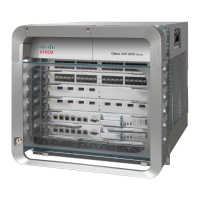113
Cisco ASR 9000 Series Aggregation Services Router Getting Started Guide
OL-28417-02
Introduction to the Cisco ASR 9000 Series Aggregation Services Router
Cisco ASR 9000 Series Router Overview
• Pseudowire Grouping— This feature enables assigning each PW a group ID that is common for all
PWs created from the same physical port. Hence, when the physical port becomes non-functional or
is deleted, L2VPN sends a single message to advertise the status change of all PWs belonging to the
group. For more information on configuring pseudowire groups, see the Implementing Point to Point
Layer 2 Services module in the Cisco ASR 9000 Series Aggregation Services Router L2VPN and
Ethernet Services Configuration Guide.
Multicast
The router supports multicast, which offers the following:
• IPv4 Multicast—IPv4 Multicast supports Internet Group Management Protocol Versions 2 and 3
(IGMPv2/v3), Protocol Independent Multicast Source Specific Multicast (SSM) and Sparse Mode
(SM), Multicast Source Discovery Protocol (MSDP), and Anycast Rendezvous Point (RP).
• IGMP v2/v3 Snooping—This Layer 2 mechanism efficiently tracks multicast membership on an
L2VPN network. Individual IGMP joins are snooped at the VLAN level or pseudowire level, and
then it summarizes the results into a single upstream join message. In residential broadband
deployments, this feature enables the network to send only channels that are being watched to the
downstream users.
OAM
The router supports different types of operations, administration, and maintenance (OAM), which offers
the following:
• E-OAM (IEEE 802.3ah)—Ethernet link layer OAM is a vital component of EOAM that provides
physical-link OAM to monitor link health and assist in fault isolation. Along with IEEE 802.1ag,
Ethernet link layer OAM can be used to assist in rapid link-failure detection and signaling to remote
end nodes of a local failure.
• E-OAM (IEEE 802.1ag)—Ethernet Connectivity Fault Management is a subset of EOAM that
provides numerous mechanisms and procedures that allow discovery and verification of the path
through IEEE 802.1 bridges and LANs.
• MPLS OAM—This protocol supports label-switched-path (LSP) ping, LSP TraceRoute, and virtual
circuit connectivity verification (VCCV). .
Layer 3 Routing
The router runs Cisco IOS XR Software, which supports Layer 3 routing and a range of IPv4 services
and routing protocols, including the following:
• Intermediate System-to-Intermediate System (IS-IS)—Integrated Intermediate IS-IS, Internet
Protocol Version 4 (IPv4), is a standards-based Interior Gateway Protocol (IGP). For more
information on IS-IS, see Cisco ASR 9000 Series Aggregation Services Router Routing
Configuration Guide.
• Open Shortest Path First (OSPF)—OSPF is an IGP developed by the OSPF working group of the
Internet Engineering Task Force (IETF). For more information on OSPF, see Cisco ASR 9000 Series
Aggregation Services Router Routing Configuration Guide.
• Static Routing—Static routes are user-defined routes that cause packets moving between a source
and a destination to take a specified path. For more information on static routing, see Cisco ASR
9000 Series Aggregation Services Router Routing Configuration Guide.

